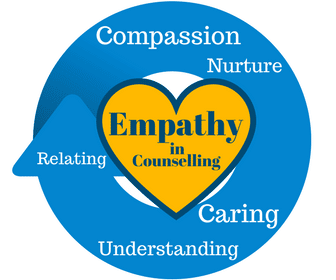Empathy in Counselling Explained
Empathy in counselling is about the counsellor seeing the client’s world as they see it.
Empathy is to respectfully perceive what the client is bringing from their frame of reference and to communicate that back in a way that makes the client feel they’ve been understood.
The empathic circle is only complete when the counsellor is able to communicate her understanding back, in such a way that the client feels they have been heard and understood.

Difference between Empathy and Sympathy
Sympathy is different from empathy.
Sympathy means we feel sorry for someone and empathy means we try to fully understand how it feels for that person.
Feeling sorry for a person is not therapeuticaly useful, but empathy is as it shows the person we truly understand what they are going through.
Empathy is perception. For empathy in counselling to be effective, we need to perceive what it is that the client is bringing, and to communicate that back in a way that makes the client feel they’ve been understood.
Perception without being able to communicate back your understanding is ineffective and does not build an empathic connection.
For example, you might be reading a book or watching a movie that is emotional, and you become very involved in a character and feel a really strong bond with them.
You are able to perceive that, but you are not able to communicate back to the actor or the person in the book. So the empathy cycle is not complete within that transaction.
"We think we listen, but very rarely do we listen with real understanding, true empathy. Yet listening, of this very special kind, is one of the most potent forces for change that I know."
Carl Ransom Rogers
Levels of Empathy
Counsellors measure the levels of empathy in the counselling relationship by using the Carkhuff and Traux rating scales. (Download your copy of the Empathy in Counselling PDF Rating Scales above.)
The benefits of empathy are apparent when the client feels, ‘Yes, this person gets me’. An empathic connection has been formed that deepens the client-counsellor relationship.
Today, there is an increasing recognition that empathy in the therapeutic relationship are vital to effective therapy.
The BACP ethical framework recognises empathy as one of the key personal qualities to which members and registrants are strongly encouraged to aspire.
Empathy is not a counselling skill as such; it is more a way of being. It is very important because it underpins the skills that we might bring to a session.
Counselling skills – reflection, paraphrasing, nonverbal communication etc. – are all worthless unless we have empathy running through them.
Carl Rogers, in developing the person-centred approach to counselling, recognised empathy as being necessary within the therapeutic relationship to bring about psychological contact.
But it doesn’t matter which approach or model of counselling you look to. Empathy must be present even in the more psychodynamic, psychoanalytical forms of therapy.
Advanced Empathy
Idiosyncratic empathy is empathy at an advanced state.
‘Idiosyncratic’ is defined as relating to the individual.
Idiosyncratic empathy means that empathy will be different depending on the person you are working with and can almost be described as "types of empathy in counselling".
If you are in the client’s frame of reference, if you’re really seeing things how they do, then empathy is going to be individual for each and every client.
The term ‘idiosyncratic empathy’ was first coined by Jerold Bozarth. He recognised that empathy in counselling needed to be different depending on what the client was bringing, who they were, and what their frame of reference was.
Thus with one client, you may find yourself laughing, with the tears rolling down your cheeks. That’s fine if that’s where the client is and what they are bringing on that day – you were with that client as they were full of joy, laughter and fun.
With the next client, you may find yourself in a very different place.
Free Handout Download
Truax and Carkhuff Empathy Scale
Recognising Our Self-Concept
Empathy is not about you, as the counsellor, getting it right or wrong.
It’s about trying to be in the client’s frame of reference and trying to get it right: almost melting yourself into that client’s world and being there with them.
In order to do this, we need to look at our own self-concept and know who we are as individuals, recognising that we bring our self-concept into the counselling relationship.

So what is our self-concept?
It’s the truths that we hold in life. It’s everything that we believe. It’s rooted in our culture, childhood, belief structure, race and sexuality.
All these things form the way that we look at the world. We project this self-structure out onto everything that we look at.
The Importance of Personal Development
It is for this reason that counselling training is personal development (PD); it requires looking within.
You may be familiar with the Johari window exercise.
Certain things are unseen by us, but they may be visible to others.
And part of the counselling journey, specifically in PD groups, is about encouraging those elements of our personality that are invisible to us – perhaps not-for-growth elements of ourselves – to come into our awareness, challenging us to look at them.
"It is most encouraging to know that this subtle, elusive quality, of utmost importance in therapy, is not something one is 'born with', but can be learned, and learned most rapidly in an empathic climate."
Carl R. Rogers
It’s about us examining our self-concept and what we believe is true and readjusting that so we can be there fully with the client, looking at their material, not through our own eyes but trying to do so through theirs.
The Importance of Not ‘Rescuing’
For example, suppose a client says, ‘I’m devastated. I’m so disgusted with myself. I’m so terribly overweight. When I look in the mirror, I just see this ugly, fat person.’
That’s tough material. That’s a hurt person who’s in a really difficult place. Hearing that, how would you respond in an empathic way, being in that client’s frame of reference?
You may be tempted to say, ‘Well, I hear what you’re saying but that’s not what I see. I see a beautiful individual in front of me.’
That would be 100% in your own frame of reference.
You are basically saying to that client, ‘No, you’re wrong. What you’re perceiving and what you’re seeing is not right. Let me tell you what I see here.’
And that is really not empathic. That is not being in the client’s frame of reference and that client will certainly not feel heard.
They may feel rescued – like you’ve thrown them a life-jacket – but they’re not going to feel heard or validated.
Using Idiosyncratic Empathy in Counselling
Idiosyncratic empathy is about reflecting back in a way that allows the client to feel heard.
So maybe the empathic response in the situation described above might be something along the lines of, ‘Wow, that sounds so terribly destroying for you that when you look in the mirror, you just see this fat person that you basically can’t stand, and recognise that that is you.’
This is certainly not rescuing the client. It’s empathic and in their frame of reference. We’re not trying to rescue them from the pain of what they feel towards their own self; we’re understanding it.
That’s what empathy in counselling is all about.
Using Questions in Counselling
As soon as we find ourselves asking questions for any reason other than to clarify our full understanding of the client’s frame of reference, we’re in our frame of reference and we break empathy.
We’re now saying to the client, "Hey, well, what happens if you do this, and what about that, and what about the next thing? Yeah, but have you tried this?" That is not within the client’s frame of reference and it is certainly not empathic.
If we are operating as person-centred counsellors, we avoid asking any questions other than to clarify our understanding.
The cycle is complete with what the client brings, how we perceive that, and how we understand that.
It’s not about us being right, but rather about:
- being fully integrated within the client’s frame of reference
- putting aside our own self-concept
- being truly with the client just for that moment
- reflecting back our understanding in such a way that the client thinks, ‘Yes, you hear me.’
Examples of Advanced Empathy
Part of being empathic is having a vocabulary to be able to describe what we perceive a client to be bringing.
So if we’re empathically connected to a client, how can we put that in words to feed this connection back to them?
It’s interesting that there are so many different ways to say things.

For example, apparently, there are many Inuit words for snow. But human beings often have very few words for their emotions. We can say ‘happy’, ‘sad’ or ‘angry’, but these seem very basic words for the underlying emotions.
Part of being reflective is looking within - looking at our own emotions and pinpointing words to describe them.
Processing your day and maybe journaling is the best way to do this.
As you journal, think what word really fits with this – because if we can find words to describe our emotions and feelings, maybe we can use those words within a counselling relationship to reflect back our understanding of what a client is bringing.
We may find that when we use a certain word, this really resonates with the client, and they go, ‘Wow, yeah. Wow, that’s the word. That’s exactly it.’
Free Handout Download
Truax and Carkhuff Empathy Scale
Empathic Feeling Words
For instance, a client might say, ‘They laid me off from my job.’
You notice that their fists and teeth are clenched as they speak to you. You see the muscles in their neck tensing up.
Would ‘angry’ be the right word for that? Or might ‘furious’ more accurately capture the strength of their feeling?
It’s about having a vocabulary that kind of turns the dial from mildly irritated right through to absolutely fuming.
As you’re saying the word that you feel to the client, how do you intonate it?
Do you sit there calmly and say, ‘You know, you look absolutely furious’?
Or do you mirror their body language and say, ‘Wow, you’re furious!’
The latter helps to put the feeling of what you’re perceiving from the client into the words that you feed back to them.
This is idiosyncratic empathy; it’s empathy is in motion. It’s happening right there and then within those moments.
It really is vital to develop your vocabulary, so you can interpret what the client is bringing and add words to unnamed feelings.
Next Steps in Using Idiosyncratic Empathy in Counselling
- Take idiosyncratic empathy into your next simulated counselling skills session and see how it is ever-changing and liquid – as individual as the clients that you will have the privilege of being with on their journey.
- If you work first with one of your peers and then with another, how different is that empathy within those two relationships?
- If you’re merely reflecting back the words the client gave, is that really an empathic connection?
- Are you looking at the individual person? Are you recognising their body language – for example, where are they looking and what are they doing with their hands?
- What type of tone are they using when they speak? We must look way beyond the words, to the person that is there bringing those words.
- Have a chat with your peers about what empathy in counselling means to them. Explain what it means to you. Get their differing opinions.